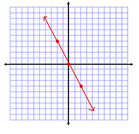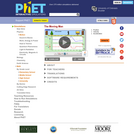
132 Results


Topics List for this Lesson: Graphing Linear EquationsSystems of Equations
- Subject:
- Mathematics
- Material Type:
- Full Course
- Author:
- Jillian Miller
- Megan Simmons
- Stefanie Holmes
- Jessica Chambers
- Brad Fox
- Ashley Morgan
- Heather Doncaster
- Misty Anderson
- Date Added:
- 07/08/2021

- Subject:
- Mathematics
- Material Type:
- Full Course
- Provider:
- Pearson
- Date Added:
- 10/06/2016

Rate
Type of Unit: Concept
Prior Knowledge
Students should be able to:
Solve problems involving all four operations with rational numbers.
Understand quantity as a number used with a unit of measurement.
Solve problems involving quantities such as distances, intervals of time, liquid volumes, masses of objects, and money, and with the units of measurement for these quantities.
Understand that a ratio is a comparison of two quantities.
Write ratios for problem situations.
Make and interpret tables, graphs, and diagrams.
Write and solve equations to represent problem situations.
Lesson Flow
In this unit, students will explore the concept of rate in a variety of contexts: beats per minute, unit prices, fuel efficiency of a car, population density, speed, and conversion factors. Students will write and refine their own definition for rate and then use it to recognize rates in different situations. Students will learn that every rate is paired with an inverse rate that is a measure of the same relationship. Students will figure out the logic of how units are used with rates. Then students will represent quantitative relationships involving rates, using tables, graphs, double number lines, and formulas, and they will see how to create one such representation when given another.
- Subject:
- Algebra
- Mathematics
- Material Type:
- Unit of Study
- Provider:
- Pearson

Gallery OverviewAllow students who have a clear understanding of the content thus far in the unit to work on Gallery problems of their choosing. You can then use this time to provide additional help to students who need review of the unit's concepts or to assist students who may have fallen behind on work.Gallery DescriptionsDog and CatStudents refer to a pre-made graph showing how much dry food a dog eats and how much dry food a cat eats over the same time period. They analyze the graph and list specific information they can conclude from the graph.Faucet Rate ProblemStudents perform research on the Internet about standard water flow rates of bathroom faucets in the United States. They test faucets at home or at school and prepare responses to the questions.Shower versus BathStudents will use their knowledge of rates to figure out which uses less water, a shower or a bath.Laps, Miles, KilometersStudents use rates to convert measures given in laps, kilometers, and miles. They justify their reasons for ordering distances given in these three units.Paper ProblemStudents write and use formulas for heights of stacks of paper. They practice writing rates for h in terms of n and for n in terms of h.Three ScalesStudents use a triple number line to convert among the units laps on a track, kilometers, and miles. Given one number line, they mark two other number lines to show equal distances in the units.Water ProblemThis problem begins with a video of a cube container being filled with colored water. Students determine what information they'd need in order to figure out the volume of water in the cube at any time.
- Subject:
- Numbers and Operations
- Material Type:
- Lesson Plan
- Date Added:
- 09/21/2015

Rational Numbers
Type of Unit: Concept
Prior Knowledge
Students should be able to:
Solve problems with positive rational numbers.
Plot positive rational numbers on a number line.
Understand the equal sign.
Use the greater than and less than symbols with positive numbers (not variables) and understand their relative positions on a number line.
Recognize the first quadrant of the coordinate plane.
Lesson Flow
The first part of this unit builds on the prerequisite skills needed to develop the concept of negative numbers, the opposites of numbers, and absolute value. The unit starts with a real-world application that uses negative numbers so that students understand the need for them. The unit then introduces the idea of the opposite of a number and its absolute value and compares the difference in the definitions. The number line and positions of numbers on the number line is at the heart of the unit, including comparing positions with less than or greater than symbols.
The second part of the unit deals with the coordinate plane and extends student knowledge to all four quadrants. Students graph geometric figures on the coordinate plane and do initial calculations of distances that are a straight line. Students conclude the unit by investigating the reflections of figures across the x- and y-axes on the coordinate plane.
- Subject:
- Mathematics
- Numbers and Operations
- Material Type:
- Unit of Study
- Provider:
- Pearson

Students play a game in which they try to find dinosaur bones in an archaeological dig simulator. The players guess where the bones are on the coordinate plane using hints and reasoning.Key ConceptsThe coordinate plane consists of a horizontal number line and a vertical number line that intersect at right angles. The point of intersection is the origin, or (0,0). The horizontal number line is often called the x-axis. The vertical number line is often called the y-axis.A point’s location on the coordinate plane can be described using words or numbers. Ordered pairs name locations on the coordinate plane. To find the location of the ordered pair (m,n), first locate m on the x-axis and draw a vertical line through this point. Then locate n on the y-axis and draw a horizontal line through this point. The intersection of these lines is the location of (m,n).The coordinate plane is divided into four quadrants:Quadrant I: (+,+)Quadrant II: (−,+)Quadrant III: (−,−)Quadrant IV: (+,−)Goals and Learning ObjectivesName locations on the coordinate plane.
- Subject:
- Numbers and Operations
- Material Type:
- Lesson Plan
- Date Added:
- 09/21/2015

Gallery OverviewAllow students who have a clear understanding of the content thus far in the unit to work on Gallery problems of their choosing. You can then use this time to provide additional help to students who need review of the unit's concepts or to assist students who may have fallen behind on work.Gallery DescriptionDivingChen stands on top of a cliff, and a woman scuba diver dives in the ocean below. Students will determine their positions on a vertical number line that represents distance above and below sea level.Negative Numbers?Students will read about five students’ opinions about negative numbers and decide whose opinions they agree with, whose they disagree with, and why. Students will also share their own ideas about negative numbers.Temperatures in JanuaryA map shows the lowest temperatures recorded in January since 2008 for five cities. Students will locate these temperatures on a number line and compare the temperatures.Greenwich Mean TimeStudents will use positive and negative numbers and Greenwich Mean Time to find the times of different cities around the world.Numbers TimelineStudents will research the history of negative numbers and absolute value and create a timeline to show what they learned.Rational Numbers and Absolute Value VideoStudents will create a video about rational numbers and absolute value.
- Subject:
- Numbers and Operations
- Material Type:
- Lesson Plan
- Date Added:
- 09/21/2015

Students reflect a figure across one of the axes on the coordinate plane and name the vertices of the reflection. As they are working, students look for and make use of structure to identify a convention for naming the coordinates of the reflected figure.Key ConceptsWhen point (m,n) is reflected across the y-axis, the reflected point is (−m,n).When point (m,n) is reflected across the x-axis, the reflected point is (m,−n).When point (m,n) is reflected across the origin (0,0), the reflected point is (−m,−n).Goals and Learning ObjectivesReflect a figure across one of the axes on the coordinate plane.Name the vertices of the reflected figure.Discern a pattern in the coordinates of the reflected figure.
- Subject:
- Numbers and Operations
- Material Type:
- Lesson Plan
- Date Added:
- 09/21/2015

Four full-year digital course, built from the ground up and fully-aligned to the Common Core State Standards, for 7th grade Mathematics. Created using research-based approaches to teaching and learning, the Open Access Common Core Course for Mathematics is designed with student-centered learning in mind, including activities for students to develop valuable 21st century skills and academic mindset.
- Subject:
- Mathematics
- Material Type:
- Full Course
- Provider:
- Pearson
- Date Added:
- 10/06/2016

Algebraic Reasoning
Type of Unit: Concept
Prior Knowledge
Students should be able to:
Add, subtract, multiply, and divide rational numbers.
Evaluate expressions for a value of a variable.
Use the distributive property to generate equivalent expressions including combining like terms.
Understand solving an equation or inequality as a process of answering a question: which values from a specified set, if any, make the equation or inequality true?
Write and solve equations of the form x+p=q and px=q for cases in which p, q, and x are non-negative rational numbers.
Understand and graph solutions to inequalities x<c or x>c.
Use equations, tables, and graphs to represent the relationship between two variables.
Relate fractions, decimals, and percents.
Solve percent problems included those involving percent of increase or percent of decrease.
Lesson Flow
This unit covers all of the Common Core State Standards for Expressions and Equations in Grade 7. Students extend what they learned in Grade 6 about evaluating expressions and using properties to write equivalent expressions. They write, evaluate, and simplify expressions that now contain both positive and negative rational numbers. They write algebraic expressions for problem situations and discuss how different equivalent expressions can be used to represent different ways of solving the same problem. They make connections between various forms of rational numbers. Students apply what they learned in Grade 6 about solving equations such as x+2=6 or 3x=12 to solving equations such as 3x+6=12 and 3(x−2)=12. Students solve these equations using formal algebraic methods. The numbers in these equations can now be rational numbers. They use estimation and mental math to estimate solutions. They learn how solving linear inequalities differs from solving linear equations and then they solve and graph linear inequalities such as −3x+4<12. Students use inequalities to solve real-world problems, solving the problem first by arithmetic and then by writing and solving an inequality. They see that the solution of the algebraic inequality may differ from the solution to the problem.
- Subject:
- Algebra
- Mathematics
- Material Type:
- Unit of Study
- Provider:
- Pearson

Students work in pairs to critique and improve their work on the Self Check. Students complete a task similar to the Self Check with a partner.Key ConceptsTo critique and improve the task from the Self Check and to complete a similar task with a partner, students use what they know about solving inequalities, graphing their solutions, and relating the inequalities to a real-world situation.Goals and Learning ObjectivesSolve algebraic inequalities.Graph the solutions of inequalities using number lines.Write word problems that match algebraic inequalities.Interpret the solution of an inequality in terms of a word problem.
- Subject:
- Algebra
- Material Type:
- Lesson Plan
- Date Added:
- 09/21/2015

Proportional Relationships
Type of Unit: Concept
Prior Knowledge
Students should be able to:
Understand what a rate and ratio are.
Make a ratio table.
Make a graph using values from a ratio table.
Lesson Flow
Students start the unit by predicting what will happen in certain situations. They intuitively discover they can predict the situations that are proportional and might have a hard time predicting the ones that are not. In Lessons 2–4, students use the same three situations to explore proportional relationships. Two of the relationships are proportional and one is not. They look at these situations in tables, equations, and graphs. After Lesson 4, students realize a proportional relationship is represented on a graph as a straight line that passes through the origin. In Lesson 5, they look at straight lines that do not represent a proportional relationship. Lesson 6 focuses on the idea of how a proportion that they solved in sixth grade relates to a proportional relationship. They follow that by looking at rates expressed as fractions, finding the unit rate (the constant of proportionality), and then using the constant of proportionality to solve a problem. In Lesson 8, students fine-tune their definition of proportional relationship by looking at situations and determining if they represent proportional relationships and justifying their reasoning. They then apply what they have learned to a situation about flags and stars and extend that thinking to comparing two prices—examining the equations and the graphs. The Putting It Together lesson has them solve two problems and then critique other student work.
Gallery 1 provides students with additional proportional relationship problems.
The second part of the unit works with percents. First, percents are tied to proportional relationships, and then students examine percent situations as formulas, graphs, and tables. They then move to a new context—salary increase—and see the similarities with sales taxes. Next, students explore percent decrease, and then they analyze inaccurate statements involving percents, explaining why the statements are incorrect. Students end this sequence of lessons with a formative assessment that focuses on percent increase and percent decrease and ties it to decimals.
Students have ample opportunities to check, deepen, and apply their understanding of proportional relationships, including percents, with the selection of problems in Gallery 2.
- Subject:
- Mathematics
- Ratios and Proportions
- Material Type:
- Unit of Study
- Provider:
- Pearson

Students analyze the graph of a proportional relationship in order to find the approximate constant of proportionality, to write the related formula, and to create a table of values that lie on the graph.Key ConceptsThe constant of proportionality determines the steepness of the straight-line graph that represents a proportional relationship. The steeper the line is, the greater the constant of proportionality.On the graph of a proportional relationship, the constant of proportionality is the constant ratio of y to x, or the slope of the line.A proportional relationship can be represented in different ways: a ratio table, a graph of a straight line through the origin, or an equation of the form y = kx, where k is the constant of proportionality.Goals and Learning ObjectivesIdentify the constant of proportionality from a graph that represents a proportional relationship.Write a formula for a graph that represents a proportional relationship.Make a table for a graph that represents a proportional relationship.Relate the constant of proportionality to the steepness of a graph that represents a proportional relationship (i.e., the steeper the line is, the greater the constant of proportionality).
- Subject:
- Ratios and Proportions
- Material Type:
- Lesson Plan
- Date Added:
- 09/21/2015

Lesson OverviewStudents calculate the constant of proportionality for a proportional relationship based on a table of values and use it to write a formula that represents the proportional relationship.Key ConceptsIf two quantities are proportional to one another, the relationship between them can be defined by a formula of the form y = kx, where k is the constant ratio of y-values to corresponding x-values. The same relationship can also be defined by the formula x=(1k)y , where 1k is now the constant ratio of x-values to y-values.Goals and Learning ObjectivesDefine the constant of proportionality.Calculate the constant of proportionality from a table of values.Write a formula using the constant of proportionality.
- Subject:
- Ratios and Proportions
- Material Type:
- Lesson Plan
- Date Added:
- 09/21/2015

Students explore the idea that not all straight lines are proportional by comparing a graph representing a stack of books with a graph representing a stack of cups. They recognize that all proportional relationships are represented as a straight line that passes through the origin.Key ConceptsNot all graphs of straight lines represent proportional relationships.There are three ways to tell whether a relationship between two varying quantities is proportional:The graph of the relationship between the quantities is a straight line that passes through the point (0, 0).You can express one quantity in terms of the other using a formula of the form y = kx.The ratios between the varying quantities are constant.Goals and Learning ObjectivesUnderstand when a graph of a straight line is and when it is not a proportional relationship.Recognize that a proportional relationship is shown on a graph as a straight line that passes through the origin (0, 0).Make a table of values to represent two quantities that vary.Graph a table of values representing two quantities that vary.Describe what each variable and number in a formula represents.
- Subject:
- Ratios and Proportions
- Material Type:
- Lesson Plan
- Date Added:
- 09/21/2015

Students continue to explore the three relationships from the previous lessons: Comparing Dimensions, Driving to the Amusement Park, and Temperatures at the Amusement Park. They graph the three situations and realize that the two proportional relationships form a straight line, but the time and temperature relationship does not.Key ConceptsA table of values that represent equivalent ratios can be graphed in the coordinate plane. The graph represents a proportional relationship in the form of a straight line that passes through the origin (0, 0). The unit rate is the slope of the line.Goals and Learning ObjectivesRepresent relationships shown in a table of values as a graph.Recognize that a proportional relationship is shown on a graph as a straight line that passes through the origin (0, 0).
- Subject:
- Ratios and Proportions
- Material Type:
- Lesson Plan
- Date Added:
- 09/21/2015

In this Assessment Routine, students use a Mind Pie chart to express how comfortable and confident they feel about certain topics and activities they will encounter during the field experience. The chart provides the instructor with some information about the group, which they can use to inform their instruction. It also gives students an idea of what to expect from the field experience. This activity does not explicitly illuminate student misconceptions, rather, it serves as an opportunity for students to access and reflect on their prior knowledge and experience.
- Subject:
- Life Science
- Material Type:
- Activity/Lab
- Provider:
- Beetles: Science and Teaching for Field Instructors
- Date Added:
- 05/06/2020

Learn about position, velocity, and acceleration graphs. Move the little man back and forth with the mouse and plot his motion. Set the position, velocity, or acceleration and let the simulation move the man for you.
- Subject:
- Physical Science
- Physics
- Material Type:
- Simulation
- Provider:
- University of Colorado Boulder
- Provider Set:
- PhET Interactive Simulations
- Author:
- Carl Wieman
- Danielle Harlow
- Kathy Perkins
- Sam Reid
- Wendy Adams
- Date Added:
- 10/04/2005

This video explains how to use graphs, including how to set up a graph, the use of variables, and how to interpret the data. Disclaimer: Host website is responsible for accessibility compliance. Educator is responsible for accommodations.
- Subject:
- Education
- Material Type:
- Diagram/Illustration
- Provider:
- NASA
- Date Added:
- 10/17/2018